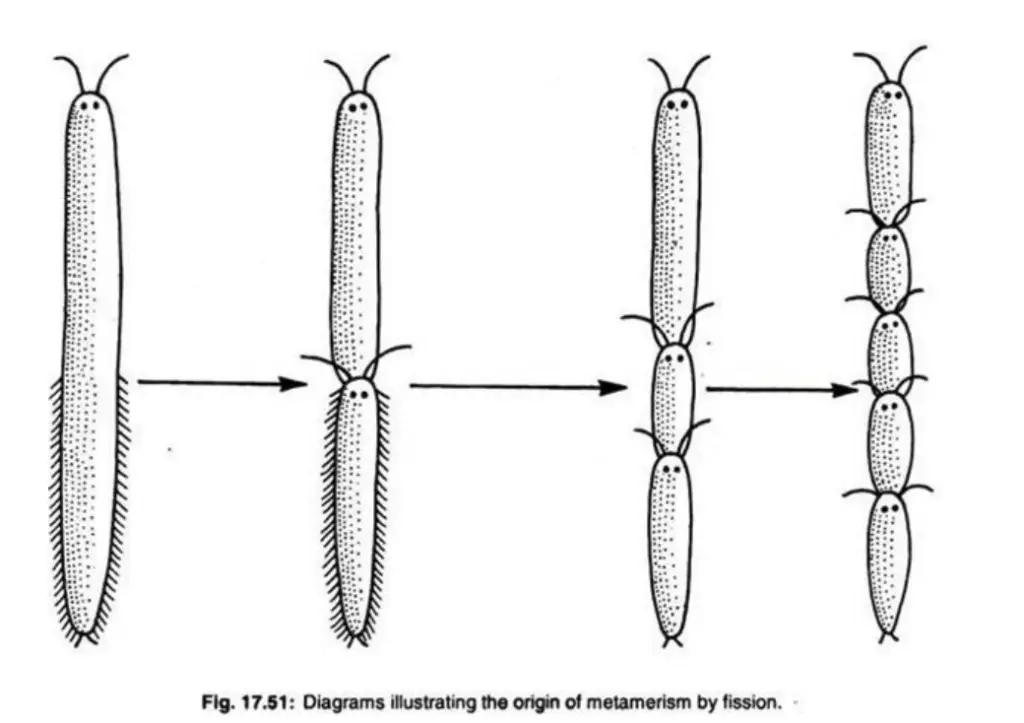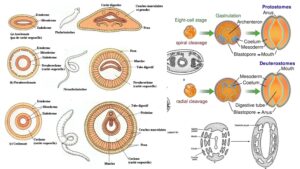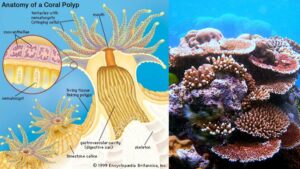What is Metamerism?
- Metamerism, or metameric segmentation, refers to a body plan found in certain animals where their bodies are organized into repeating segments. Each segment, known as a metamere or somite, is structurally similar and organized to serve specific functions. This type of segmentation can be observed in several invertebrate and vertebrate species, including annelids, arthropods, and some chordates.
- Metamerism allows for the repetition of similar body parts, such as muscles, nerves, and other organs, which are distributed across the segments. Each segment can be thought of as a modular unit, equipped with a subset of the organism’s organ systems. Although segments are identical in the fundamental blueprint, various modifications can occur over time, such as the fusion or simplification of certain segments or the differentiation of others.
- The organization of metamerism plays a crucial role in enhancing the functional efficiency of these organisms. For example, repeated segments can aid in the coordinated movement of the animal. Each segment, containing elements of the circulatory, nervous, and digestive systems, can perform its functions independently, allowing for greater flexibility and adaptability. Additionally, this segmentation facilitates easier growth and development by allowing segments to be added or modified without altering the entire organism’s structure.
- However, while each segment shares a basic structure, metamerism is not always uniform across all species. In some organisms, certain segments become specialized for particular functions, a process known as regional differentiation. Over time, some segments may merge, lose certain organ systems, or undergo further specialization based on environmental or evolutionary pressures.
Occurrence of Metamerism
The occurrence of metamerism, a body organization in which segments are repeated serially along an organism’s body, can be observed across several distinct groups in the animal kingdom. This type of segmentation, although relatively rare, provides significant structural and functional advantages, contributing to the adaptability and evolution of certain organisms.
- Annelids: Metamerism is most notably observed in annelids, where it is considered a defining feature. Each segment of the body typically contains a variety of internal organs and structures, such as appendages, muscles, nerves, blood vessels, excretory organs, and a pair of coelomic sacs. The repeated presence of these structures in each segment provides the annelids with both structural redundancy and flexibility, enabling efficient movement and functionality across their body. This segmentation is critical to their locomotion and response to environmental stimuli.
- Arthropods: Metamerism is also present in arthropods, including insects, crustaceans, and arachnids. In these animals, the segmentation is more pronounced, with each segment contributing to specialized functions. For instance, different segments might develop into specialized appendages for walking, feeding, or sensing the environment. The repeated segments are fundamental to the overall body structure, helping arthropods achieve precise movement, and supporting organ systems necessary for survival.
- Kinorhynchs: These microscopic marine organisms also exhibit metamerism, although they are less studied. Like annelids and arthropods, their body is segmented, though the specific structures and functions of these segments may differ in some respects. The presence of segmentation in kinorhynchs, however, highlights the wide distribution of this body plan in the animal kingdom.
- Chordates: In the chordate line, metamerism is evident in both vertebrates and some invertebrates. In some chordates, especially those that retain a primitive form of segmentation in their embryonic stages, the repetition of segments may contribute to the formation of structures like the vertebral column and muscles that assist in locomotion. Though the segmentation in chordates may not always be as visibly prominent as in annelids or arthropods, its presence is crucial to the development of their complex organ systems.
- Cestodes (Tapeworms): A more controversial example of metamerism occurs in the cestode group, where some researchers suggest that metameric segmentation is present. However, it is important to note that this metamerism differs from that in annelids, arthropods, and chordates. Cestodes display segmentation primarily in their proglottids, the reproductive units of their body, which are segmented from one another but not in the same functional sense as in other metamerically segmented animals.
- Independent Evolution: Current scientific consensus suggests that metamerism evolved independently at least three times in different groups of animals. These three evolutionary events are believed to have occurred in:
- The annelid and arthropod lines, where segmentation became a key feature in both groups.
- The chordate line, where segmentation contributed to the formation of vertebrates.
- The cestode line, where segmentation occurs primarily in the reproductive system, albeit with a different functional role compared to other metameric groups.
Characteristic Features of Metamerism
The characteristic features of metamerism define how these segments function and relate to one another within the organism.
- Confined to Intermediate Segments: Metamerism is generally restricted to the intermediate or trunk segments of the body. The anterior segment, often called the acron or head, and the posterior segment, known as the pygidium or telson, do not exhibit this segmented arrangement. These regions typically serve specialized functions, such as sensory processing or locomotion, and do not participate in the repetitive segmentation that occurs in the trunk.
- Mirror Image Structure: Each metamere, or body segment, is typically a mirror image of the others in terms of structure. This means that the organs and systems within one segment are essentially duplicated in subsequent segments, providing a modular and symmetrical body design. This symmetry is essential for maintaining the organism’s balance and coordination during movement.
- Segmental Interdependence: Despite their repeated nature, the segments are not entirely independent. Each segment is functionally linked to the others. The interaction between segments is crucial for maintaining overall body function, as they often work in unison. For instance, muscles in adjacent segments might contract simultaneously, enabling coordinated movement. Therefore, the segmentation does not result in isolated segments, but rather a cooperative and integrated system.
- Integration into a Functional Unit: The segmental structures, while repeated, are integrated into a single functional unit. Each segment contributes to the overall performance of the organism, whether in movement, feeding, or other physiological processes. This integration ensures that the animal can function as a cohesive entity rather than as a collection of disjointed parts. For example, the nervous and circulatory systems are typically organized to connect segments, ensuring proper communication and support across the entire body.
- Coordination of Segments: The segments of the body work in harmony to perform complex tasks. This coordination is essential for activities such as locomotion, where muscles in multiple segments must contract and relax in a synchronized manner. Additionally, coordination across segments helps ensure that organ systems within each metamere function properly together, supporting the overall homeostasis of the organism.
Types of Metamerism
Metamerism, the repetitive segmentation of the body along an animal’s length, is categorized into several distinct types based on how the segmentation occurs and how the segments relate to each other and the organism’s body systems. These various types of metamerism can be found across different animal groups, including annelids, arthropods, and chordates, among others.

- True Metamerism: In true metamerism, the segmentation of the body arises through the segmentation of the mesoderm, one of the primary germ layers during embryonic development. This type of segmentation is characteristic of annelids, arthropods, and most chordates. In annelids, the body consists of a series of identical segments, and this number remains constant for a particular species, even after maturation. Once the organism has reached maturity, no new segments are added, meaning the body’s segments are all of the same age. These segments are interdependent, working together as an integrated unit. New segments form at the posterior end, just in front of the pygidium, and older segments remain behind the head. This ensures that the animal maintains a consistent body structure throughout its life.
- Homonomous Metamerism: This type of metamerism occurs when all the segments or somites in an animal are structurally identical. This is the case in many annelids, where each segment contains a full set of segmental organs, such as blood vessels, nerves, nephridia (excretory organs), and coelomoducts. Homonomous metamerism represents a more primitive form of segmentation and is not found in many modern animals. In annelids, although each segment is similar, there is no distinct formation of a head or cephalization. However, some polychaetes show limited cephalization through modifications of anterior structures, such as the development of parapodial cirri. These changes suggest a transition toward a more defined head region, but true cephalization remains absent.
- Heteronomous Metamerism: In contrast to homonomous metamerism, heteronomous metamerism involves segments that differ in structure and function across various parts of the body. This type of segmentation is observed in arthropods and chordates, where different body regions exhibit distinct segments, each specialized for specific functions. For example, in arthropods, the body segments may differentiate to form specialized appendages for locomotion or feeding, while in chordates, certain regions, such as the head or tail, may show specialized organ development.
- External Metamerism: This type of metamerism is visible from the outside of the organism. In arthropods, for instance, the segments are externally marked, but there may be no internal divisions between the segments. This means that although the segmentation can be seen externally, it is not always reflected in the internal structures of the body.
- Internal Metamerism: Internal metamerism is most evident in vertebrates, especially during embryonic development. In this form of metamerism, segmentation is reflected in the internal structures such as the muscles, skeleton (vertebrae and ribs), and nervous system. The segments may not be externally visible, but they are integral to the organization of these internal systems.
- External and Internal Metamerism: In annelids, both external and internal metamerism are clearly visible. Externally, the body is marked by constrictions, while internally, these segments are divided by septa (partitions). This dual manifestation of metamerism enhances the organism’s ability to move and function as a coordinated unit.
- Complete Metamerism: When segmentation extends to nearly all organ systems, it is referred to as complete metamerism. This is evident in annelids, where segmentation is not only visible externally and internally but also reflected in the majority of their physiological systems, including the nervous, circulatory, and digestive systems. The complete segmentation allows for efficient coordination and function across all segments.
- Incomplete Metamerism: In contrast to complete metamerism, incomplete metamerism is when segmentation is not reflected across all organ systems. This type of metamerism is seen in arthropods and chordates. Although segmentation may be evident externally or in certain internal structures, it is not present in all systems. For instance, while arthropods display external metamerism, their internal segmentation may be less prominent.
- Pseudo-metamerism or Strobilization: Pseudo-metamerism, also called strobilization, is a form of segmentation observed in tapeworms (Platyhelminthes), where the body segments, or proglottids, are formed by the segmentation of the ectoderm, rather than the mesoderm. These segments vary in development across individuals, and new proglottids continue to form throughout the life of the organism. However, unlike true metamerism, the segments in tapeworms are functionally independent and self-contained, with no cooperation between segments. Proglottids are continuously added at the anterior end, behind the scolex (head), which represents the organism’s attachment structure.
Origin of Metamerism
The origin of metamerism, the repetitive segmentation seen in some animals, remains a topic of ongoing debate among scientists. Several theories attempt to explain how this characteristic evolved in different animal groups. These theories focus on varying aspects such as body organization, organ development, and adaptation to specific environmental and functional demands.

- Pseudo-Metamerism Theory: This theory suggests that metamerism evolved secondarily through the repetition of body parts in an unsegmented, acoelomate ancestor. In this view, the ancestor of segmented animals was originally unsegmented, and organs such as testes, yolk glands, and nerve cords were repeatedly arranged along the body. Over time, the segmentation observed in animals like tapeworms (Platyhelminthes) evolved by the development of septa that separated these repeated organs, resulting in pseudo-segmentation. In pseudo-metamerism, the segments formed through ectodermal segmentation do not work in coordination, and new segments are formed at the anterior end of the body. These segments function as independent units without much interaction. This type of segmentation contrasts with true metamerism, where mesodermal segmentation results in the coordination of segments and the formation of new segments at the posterior end.
- Cyclomerism Theory: Proposed by Sedgwick in 1884 and supported later by Remane, this theory links the origin of metamerism with the origin of the coelom. According to this theory, the coelom developed from the gastric pouches of ancestral coelenterates, specifically anthozoans. These pouches, initially part of the gastric cavity, became separated and aligned in a linear fashion. As these pouches transformed into coelomic cavities, the first set of coelomic cavities developed into a structure known as the protocoel. Subsequent division of these pouches produced further coelomic cavities, leading to the formation of segmented bodies. In this context, the metameric segmentation in annelids, for instance, resulted from the subdivision of a metacoel (posterior pouch), while the loss of protocoel and mesocoel led to the formation of unsegmented organisms like molluscs and sipunculans. This theory suggests that segmentation in the animal kingdom arose in connection with the evolution of the coelom.
- Corm or Fission Theory: This theory proposes that metamerism originated through the incomplete separation of a non-segmented ancestor. Repeated transverse divisions, or asexual reproduction leading to a chain of sub-individuals, might have resulted in a serial arrangement of zooids (individuals) connected end to end. This type of segmentation, which is observed in some scyphozoans and platyhelminthes, would have involved the fusion of subunits to form a single organism. However, this theory has limitations, including the fact that zooid formation in these groups is not always serial, and fission typically occurs in sessile animals, whereas the ancestors of these groups were likely free-swimming. This challenges the validity of fission as a consistent mechanism for the origin of metamerism.
- Locomotion Theory: This theory, proposed by R. B. Clark in 1964, links the evolution of metamerism to the demands of locomotion. According to Clark, metamerism in annelids evolved as an adaptation to peristaltic movement, which is necessary for burrowing. In peristalsis, the animal shortens and lengthens its body through the contraction and relaxation of circular and longitudinal muscles, respectively. The coelom, filled with fluid, serves as a hydrostatic skeleton, enabling this movement. However, peristaltic movement is difficult without internal partitions, like septa, that compartmentalize the coelomic fluid. These septa help confine fluid pressure to specific body regions, allowing one part of the body to contract while others relax, thereby facilitating the propagation of peristaltic waves. In addition to locomotion, the septa and fluid compartments are critical for burrowing, as they act as a hydraulic skeleton in the absence of a hard skeleton. This theory also extends to chordates, where metamerism evolved independently for undulatory, serpentine swimming. In chordates, segmentation allowed for the arrangement of tail muscles that aid in the smooth, coordinated movement of the body.

Significance of Metamerism
The following points highlight the major functions and advantages of metamerism.
- Enhanced Locomotion: One of the key advantages of metamerism is its contribution to efficient locomotion. In animals such as annelids, metameric segmentation enables coordinated movement through peristalsis, a wave-like motion involving the contraction and relaxation of circular and longitudinal muscles. This segmentation allows the body to move in a flexible, coordinated manner, facilitating various types of locomotion. Besides burrowing, where it acts as a hydraulic skeleton, metamerism also plays a vital role in other forms of movement such as swimming and crawling. The segmentation enables parts of the body to move independently, yet in coordination with the rest, thus promoting a more controlled and effective movement through different media.
- Division of Labor: Metamerism allows for specialization of segments, leading to a division of labor across different parts of the body. This division enhances the organism’s efficiency in carrying out different physiological processes. For example, in annelids, each segment can contain organs such as nephridia (excretory organs), ganglia (nerve centers), and blood vessels, all functioning independently within their respective segments. The repeated structures allow the organism to perform necessary functions like respiration, excretion, and nervous coordination across its length, without requiring a single centralized organ system to control everything. Thus, metamerism enables organisms to perform complex tasks more efficiently by delegating them across different body segments.
- Flexibility and Regeneration: Metamerism also contributes to the flexibility and regenerative abilities of segmented organisms. If one segment is damaged, the remaining segments can often compensate for the loss, and in many cases, the damaged part can regenerate. This feature is particularly significant in animals like earthworms, where segments can regenerate lost or damaged body parts, ensuring that the organism remains functional despite injury.
- Efficient Organ Functionality: The division of the body into distinct segments allows for the specialization of organs within each segment. For example, in the case of annelids, each segment can house its own set of organs such as muscles, coelomic sacs, and circulatory components. This segmentation ensures that each organ system functions efficiently within its respective segment, contributing to the overall health and maintenance of the organism.



